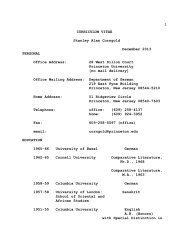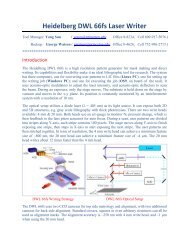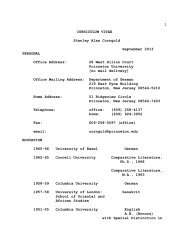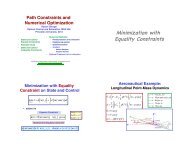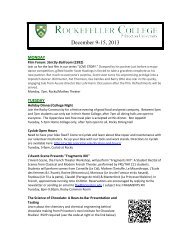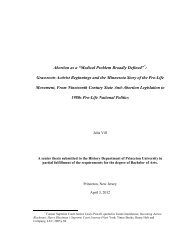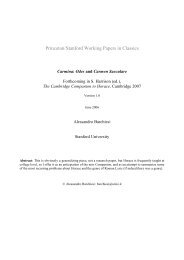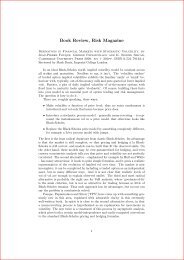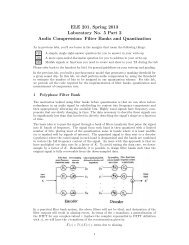Parametric and Nonparametric Linkage Analysis - Princeton University
Parametric and Nonparametric Linkage Analysis - Princeton University
Parametric and Nonparametric Linkage Analysis - Princeton University
Create successful ePaper yourself
Turn your PDF publications into a flip-book with our unique Google optimized e-Paper software.
Kruglyak et al.: <strong>Parametric</strong> <strong>and</strong> <strong>Nonparametric</strong> <strong>Linkage</strong> <strong>Analysis</strong><br />
pendent r<strong>and</strong>om variables.) The significance level of<br />
an observation Zobs can then be approximated by<br />
consulting a table of tail probabilities for the st<strong>and</strong>ard<br />
normal. Although less precise than the exact<br />
distribution, the normal approximation is useful in<br />
some settings.<br />
Imperfect Data<br />
We have so far considered the situation in which the<br />
inheritance vector is known with certainty. In fact, it is<br />
straightforward to extend Z to the general case, by taking<br />
its expected value over the inheritance distribution,<br />
as in equation (2): Z(x,F) = 4wev Z(wA) Prob[v(x)<br />
= w], where the probability distribution over inheritance<br />
vectors here refers to the joint distribution over<br />
all pedigrees. To be precise, for a single pedigree we<br />
replace S(v) by SKin equation (3); the normalized scores<br />
for individual pedigrees are then combined into an overall<br />
score as in equation (4).<br />
The only complication is in evaluating the statistical<br />
significance of Z. Because Z is the expectation over the<br />
observed inheritance distribution, its statistical properties<br />
depend on the distribution of possible inheritance<br />
distributions (given the markers <strong>and</strong> pedigree structure).<br />
This distribution could be explicitly studied by Monte<br />
Carlo sampling from all possible realizations of the<br />
marker data. However, it is not hard to show that Z<br />
has the following properties under the null hypothesis<br />
of no linkage (see appendix D):<br />
1.<br />
2.<br />
mean(Z) = mean(Z) = 0;<br />
variance(Z) -<br />
variance(Z) = 1;<br />
3. Z is asymptotically normally distributed as one studies<br />
a large number of similar pedigrees.<br />
Moreover, Z approaches Z as information content approaches<br />
100%, under both the null hypothesis of no<br />
linkage <strong>and</strong> the alternative hypothesis of linkage. Given<br />
these properties, it seems reasonable to evaluate the statistical<br />
significance of an observation Zobs by using the<br />
null distribution of Z expected in the case of complete<br />
informativeness. The significance level is likely to be<br />
conservative (in view of 1 <strong>and</strong> 2; eqq. [5] <strong>and</strong> [6]) <strong>and</strong><br />
becomes increasingly accurate as information content<br />
increases. We will refer to this approach as the perfectdata<br />
approximation.<br />
Simulation studies (see below) show that the perfectdata<br />
approximation is indeed conservative but that it<br />
sacrifices relatively little power except when information<br />
content is very low. Indeed, significance levels appear to<br />
be within twofold of the empirical values obtained from<br />
simulations. The approximation should thus not hamper<br />
initial detection of interesting regions <strong>and</strong> should grow<br />
I<br />
II<br />
inl<br />
Figure 6 Pedigree structure used in the power simulations. Disease<br />
inheritance was simulated for four models: dominant, recessive,<br />
<strong>and</strong> two intermediate models (for details on the models, see table 1).<br />
Pedigrees were selected for analysis if they had at least three affecteds<br />
in generation III, including at least one affected individual in each<br />
sibship. Individuals in generation I were assumed to be unavailable<br />
for genotyping. Genotypic data were simulated for 11 markers spaced<br />
every 10 cM on a 100-cM map; all markers had five equally frequent<br />
alleles (heterogeneity .8). The disease locus was assumed to lie in the<br />
middle of the map, exactly at marker 6. A total of 100 pedigrees were<br />
simulated for each model, <strong>and</strong> 100 sets of 5 or 10 pedigrees each<br />
(depending on the model; see table 1) were resampled from this initial<br />
set for power calculations.<br />
increasingly accurate as one genotypes additional markers<br />
in these regions.<br />
Implementation<br />
We have implemented the calculation of both NPLpairs<br />
<strong>and</strong> NPLall scores within GENEHUNTER. Given the<br />
inheritance distribution at each point in the genome, the<br />
calculation of NPL scores is rapid. The program reports<br />
the normalized score Zi for each pedigree, the overall<br />
statistic Z, <strong>and</strong> the significance levels for the perfectdata<br />
approximation based on the exact approach.<br />
Although we have focused only on Spairs <strong>and</strong> Sal, it is<br />
straightforward to substitute other scoring functions to<br />
include further information about sharing among affected<br />
individuals or even about nonsharing between<br />
affected individuals <strong>and</strong> unaffected individuals. Such<br />
scoring functions can be easily incorporated into GENE-<br />
HUNTER.<br />
Evaluation of NPL <strong>Analysis</strong><br />
1355<br />
Power Comparisons<br />
We compared the performance of the various linkage<br />
methods on simulated data, assuming dominant, recessive,<br />
<strong>and</strong> two intermediate models <strong>and</strong> a 10-cM genetic<br />
map with markers having heterozygosity of 80%. The<br />
pedigree structure used in the simulations is shown in<br />
figure 6 (for details, see the legend to fig. 6). The pedigrees<br />
were analyzed by using complete multipoint parametric<br />
linkage analysis (under the model used to generate<br />
the data), complete multipoint NPL analysis (using<br />
both the Spairs <strong>and</strong> Saii scoring functions), <strong>and</strong> APM analysis<br />
(Weeks <strong>and</strong> Lange 1988, 1992). The performance




